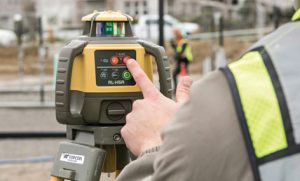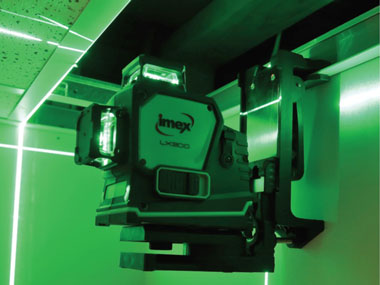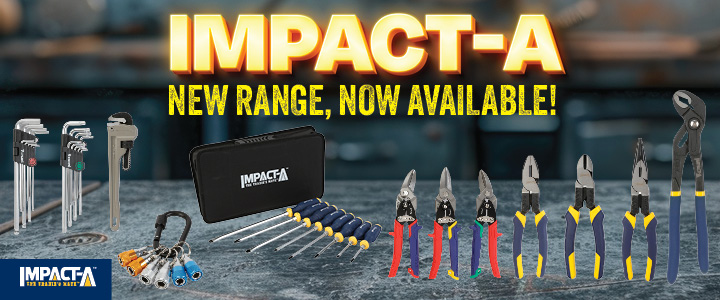Following a straight line is often harder than it looks. But what should you look for when selecting a laser to help ensure a level point?
By Tracey Porter
Laser levels are the first line of defence against everything from uneven plumbing to crooked garden beds.
Primarily used for internal and external construction tasks requiring a level point or straight line, they offer a degree of accuracy many thousands of times more precise than the old-school tape measures relied upon by traditional craftsmen and women.
But there is no such thing as one size-fits-all approach when it comes to picking the right tool for the job—and when it comes to lasers, accuracy and authenticity are everything.

The Options Available
Used by everyone from electricians and flooring experts to landscapers and tilers, modern lasers can broadly be categorised into three different models: dot, liner or rotating.
IMEX national sales manager Carl Sandeman says there are vast differences in the features, functions and laser level distances offered between the three therefore it’s important to understand the strengths of each to ensure you select the correct one for the task at hand.
Sandeman says most basic level lasers come in the form of a plumb or dot laser which produces a single or multiple points of reference on a wall or work surface.
A line laser—which emits a line beam, usually one horizontal and between one and four vertically—is slightly more complex. Used for tiling, kitchen or cabinet set-out, electrical drywall set-up and partitioning, this type of laser is visible over distances up to around 10 metres.
Sandeman, whose company has been manufacturing lasers since 2008, says the third, and perhaps hardest working offering is a rotating laser. Typically used for concreting, excavation, suspended ceiling set-up and earthworks, this type of laser has a diode prism that spins at fast speeds. It is usually mounted on a standard tripod and works in conjunction with a detector on a measuring staff which picks up the beam.
Pricing A Key Consideration
It should come as no surprise that pricing of the different types of lasers also varies significantly. Sandeman says while an entry level line laser is likely to set you back between $350 and $1000, a rotary laser can cost anywhere from $1000 to $5000 or more.
At the top end of the pricing scale is a drainage pipe laser which can cost upwards of $7000. “Generally the higher the unit cost, the more added features like gradient, scan, vertical etc. the unit will have,” he says.
Sandeman says all reputatable brands sold through licensed dealers and with similar features should be around the same price.
“With the rise of pirated copies and global giants who work on low margins, there is a proliferation of similar looking tools that sell for sometimes up to 50 per cent cheaper. These may not have metal internal components, back-up, proper warranties, the same features and accessories and proper accuracy. Generally they will not have individual pre-calibration checks.”
As a general rule for a professional tradesperson, if a laser level has similar features and functions, always purchase the more expensive known brand, rather than an unknown brand with no local service network, he says.
Red Or Green Beam?
Any decision should not be based on price alone however, and another important consideration is whether to select a red or green beam.
Sandeman says the frequency of a green beam is such that the human eye can detect it four times better that red.
“A laser with a green diode therefore emits a beam that can be seen over a longer distance, and therefore in many instances, does not require the detector and will be seen from the rotating laser as a solid line. This is a big advantage in interior work.”
Sandeman says green beam is the best selection for all-round construction and tradesmen who do a mix of interior and exterior work. A green beam laser is not compatible with a red beam detector, so for earthmoving, where machine control receivers are used, green is not applicable, he says.
Accuracy – An Essential Component
Position Partners building business manager David Gentle says the accuracy of each laser is also another important factor to consider.
Gentle, whose company distributes the brands of Topcon and aLine laser levels via a network of hardware stores and tool shops, for example CSS Group stores, says the accuracy decreases the further away you are from the laser, so any accuracy statements need to be given at the same distance to offer a true comparison.
“A leading rotating laser level will offer an accuracy of +/- 1.5mm at 30-metres, while a budget system might be double that at +/- 3mm at 30-metres,” he says.
Let The Laser Do The Hard Work
Sandeman says not all laser units are self-levelling with cheaper rotating laser levels needing to be levelled every time they are set up or moved by the operator.
These are known as compensated lasers where the diode is rigidly mounted to the mainframe. That said, Gentle says the majority of leading laser levels available today are self-levelling, although some more basic models will have a bubble vial to manually level the unit on a tripod or flat surface.
Self-levelling helps users to work as accurately as possible by ensuring the unit is truly level before beginning work.
“Many also feature a height alert function, whereby if the unit is bumped or knocked on site it will automatically sound an alert and stop working to prevent users working when the system may no longer be level,” he says.
The Final Word
Laser levels are instruments and are subject to harsh use in our working environment and as such require calibration and servicing on a regular basis, Sandeman says.
“If a laser is used daily, such as a concreter’s laser, [we] suggest every six months for a check-up. If a laser is used more infrequently, every one or two years for a calibration is usually fine, unless you suspect it has been bumped, dropped or otherwise ill-treated.”






